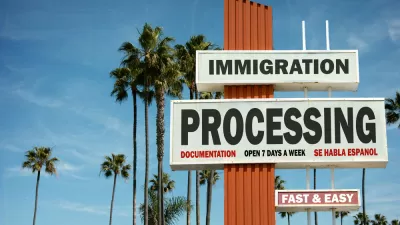The immigration trends in the United States are both changing quickly and a long time in the making, according to new research by the Pew Research Center
"The U.S. immigration picture is changing fast: Migration from Latin America, and especially Mexico, is falling and has been overtaken by immigration from Asia," reports Ben Casselman, citing a report released at the end of June by the Pew Research Center.
The Latino population is growing quickly, "but that growth isn’t due to immigration and hasn’t been for more than a decade. In 2013, according to the Pew Research Center, immigration accounted for just 22 percent of Latino population growth. The rest was due to 'natural increase' (births minus deaths). For Asians, the numbers are nearly reversed: 61 percent of growth in the U.S. Asian and Asian-American population is due to immigration."
That means more and more of the U.S. Latino population was born in the United States, and that, according to Casselman, has implications for Latino culture and the American economy: "Political commentary often treats the issues of immigration and Hispanic ethnicity as two sides of the same coin. But U.S. Latinos are looking more and more like other Americans."
FULL STORY: U.S. Hispanic and Asian populations growing, but for different reasons

Planetizen Federal Action Tracker
A weekly monitor of how Trump’s orders and actions are impacting planners and planning in America.

Maui's Vacation Rental Debate Turns Ugly
Verbal attacks, misinformation campaigns and fistfights plague a high-stakes debate to convert thousands of vacation rentals into long-term housing.

Restaurant Patios Were a Pandemic Win — Why Were They so Hard to Keep?
Social distancing requirements and changes in travel patterns prompted cities to pilot new uses for street and sidewalk space. Then it got complicated.

In California Battle of Housing vs. Environment, Housing Just Won
A new state law significantly limits the power of CEQA, an environmental review law that served as a powerful tool for blocking new development.

Boulder Eliminates Parking Minimums Citywide
Officials estimate the cost of building a single underground parking space at up to $100,000.

Orange County, Florida Adopts Largest US “Sprawl Repair” Code
The ‘Orange Code’ seeks to rectify decades of sprawl-inducing, car-oriented development.
Urban Design for Planners 1: Software Tools
This six-course series explores essential urban design concepts using open source software and equips planners with the tools they need to participate fully in the urban design process.
Planning for Universal Design
Learn the tools for implementing Universal Design in planning regulations.
Heyer Gruel & Associates PA
JM Goldson LLC
Custer County Colorado
City of Camden Redevelopment Agency
City of Astoria
Transportation Research & Education Center (TREC) at Portland State University
Jefferson Parish Government
Camden Redevelopment Agency
City of Claremont




























